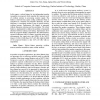2047 search results - page 204 / 410 » The limits of speech recognition |
ICPR
2004
IEEE
14 years 11 months ago
2004
IEEE
This paper presents a novel extension of Hidden Markov Models (HMMs): type-2 fuzzy HMMs (type-2 FHMMs). The advantage of this extension is that it can handle both randomness and f...
ICPR
2002
IEEE
14 years 11 months ago
2002
IEEE
This paper describes an interactive vision system for a robot that finds an object specified by a user and brings it to the user. The system first registers object models automati...
INTERSPEECH
2010
13 years 5 months ago
2010
Usually the mel-frequency cepstral coefficients (MFCCs) are derived via Hamming windowed DFT spectrum. In this paper, we advocate to use a so-called multitaper method instead. Mul...
ICASSP
2011
IEEE
13 years 1 months ago
2011
IEEE
We present a study on purely data-based recognition of animal sounds, performing evaluation on a real-world database obtained from the Humboldt-University Animal Sound Archive. As...
ICASSP
2011
IEEE
13 years 1 months ago
2011
IEEE
In this paper, a robust feature for text-independent speaker recognition is proposed, which simulate the response mode of cochlear neurons in processing acoustic signal. The featu...

